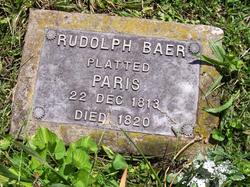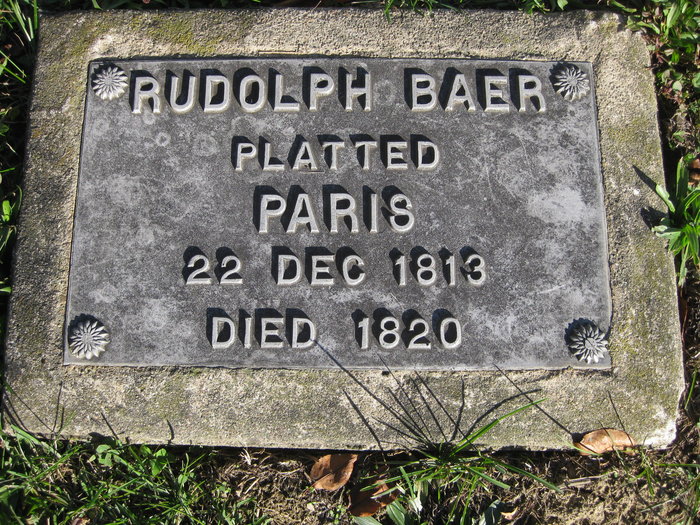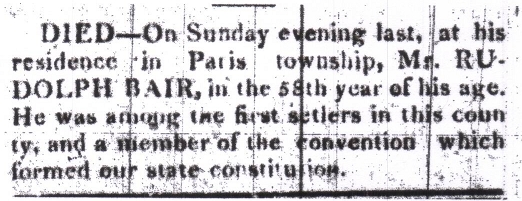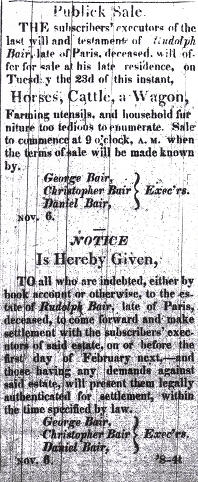He married about 1782 to Barbara Yerian.
He is said to have been the first white settler in what later became Paris Township, Stark County, Ohio, having moved there from Columbiana County, Ohio, in 1806.
For further biographical details see "History of Stark County, Ohio", edited by William Henry Perrin, Baskin and Battey, Historical Publishers, Chicago, 1881, pages 502-503.
Birth year shown above assumed from stated age at death.
Besides the children linked below they had:
George Bair b.ca.1785 Westmoreland Co, PA. Possibly George Bair. He married Marian and had a son George Jr.
The Ohio Repository, newspaper, has a notice about his death Nov 5, 1819 p.3 Col.2, this is Friday so would make his death date 31 Oct 1819.
"DIED--On Sunday evening last, at his residence in Paris township, Mr. RUDOLPH BAIR, in the 59th year of his age. He was among the first setlers in this county, and a member of the convention which formed our state constitution."
-Source: Cathy Walston
Old landmarks of Canton and Stark County, Ohio (1904), pages 65-66:
"The man most prominently identified with the settlement of Paris township was Rudolph Bair. He was born in York county, Pennsylvania, and when grown removed to Columbiana county, then a part of Jefferson, and when Ohio was yet a territory. At the call for a convention in 1802 to frame the state constitution, Bair was chosen as one of the delegates. The convention completed the work for which they had assembled in twenty-nine days, an example of industry and faithfulness contrasted with the disposition of many of our officials at the present day. Bair was a member of the first legislature after the adoption of the constitution, which met in Chillicothe on March 8, 1803. Rudolph Bair, Sr. [Jr.], generally called "Rudy" Bair, was a man of more than ordinary ability. Though his education was limited, his natural Endowments were above the average. He had a liberal share of good, common sense, a qualification not acquired at college. Such confidence had the community in his judgment and disposition to do right between man and man, that he was a very general referee to settle questions of difference, and from his decision no appeal was taken. He was a member of the German Reformed church, and his daily life was consistent with his religious professions. Though known as a farmer, his business was more particularly that of a land speculator. To accommodate emigrants of limited means he often sold land on long-time payments, and though these were not always met when due, he was never known to oppress a delinquent. Rudolph Bair died in 1820, and is buried in the ground he gave to the town of Paris for a cemetery. The walnut slab erected to mark his grave has long since gone to decay, and there is now nothing by which a stranger could identify the place where he was buried. The citizens of Paris, of which village he was a founder, owe it to themselves to erect a suitable monument over his resting place.
[There is now a modest plaque in his rememberance]
In the summer of 1806 Rudolph Bair and his brother Christopher made a trip on horse-
back through the eastern portion of Stark county, with the view of selecting land to enter. They continued their explorations along each side of what was later known as the State road, at that time a mere bridle path. They selected a number of quarter sections in Paris and Osnaburg townships, which they entered in the land office at Steubenville. Among the number was the south half of section 5. On this place Rudolph Bair, Jr., settled in the fall of the same year. He built a log cabin, into which he moved with all his household goods before the floor was laid or the doors hung.
As a substitute for the latter, a quilt was suspended from wooden pins. In this rude shanty the wife was left alone with her young babe several days and nights while her husband returned to Columbiana for supplies. There were Indians camped on the creek a short distance below, where the State road crossed the creek, but there was no white person nearer than Osnaburg, five miles distant. At night the wolves came howling around the cabin and in order to frighten them off Mrs. Bair would throw out chunks of fire, which had the effect to keep the wolves at a respectable distance."
He married about 1782 to Barbara Yerian.
He is said to have been the first white settler in what later became Paris Township, Stark County, Ohio, having moved there from Columbiana County, Ohio, in 1806.
For further biographical details see "History of Stark County, Ohio", edited by William Henry Perrin, Baskin and Battey, Historical Publishers, Chicago, 1881, pages 502-503.
Birth year shown above assumed from stated age at death.
Besides the children linked below they had:
George Bair b.ca.1785 Westmoreland Co, PA. Possibly George Bair. He married Marian and had a son George Jr.
The Ohio Repository, newspaper, has a notice about his death Nov 5, 1819 p.3 Col.2, this is Friday so would make his death date 31 Oct 1819.
"DIED--On Sunday evening last, at his residence in Paris township, Mr. RUDOLPH BAIR, in the 59th year of his age. He was among the first setlers in this county, and a member of the convention which formed our state constitution."
-Source: Cathy Walston
Old landmarks of Canton and Stark County, Ohio (1904), pages 65-66:
"The man most prominently identified with the settlement of Paris township was Rudolph Bair. He was born in York county, Pennsylvania, and when grown removed to Columbiana county, then a part of Jefferson, and when Ohio was yet a territory. At the call for a convention in 1802 to frame the state constitution, Bair was chosen as one of the delegates. The convention completed the work for which they had assembled in twenty-nine days, an example of industry and faithfulness contrasted with the disposition of many of our officials at the present day. Bair was a member of the first legislature after the adoption of the constitution, which met in Chillicothe on March 8, 1803. Rudolph Bair, Sr. [Jr.], generally called "Rudy" Bair, was a man of more than ordinary ability. Though his education was limited, his natural Endowments were above the average. He had a liberal share of good, common sense, a qualification not acquired at college. Such confidence had the community in his judgment and disposition to do right between man and man, that he was a very general referee to settle questions of difference, and from his decision no appeal was taken. He was a member of the German Reformed church, and his daily life was consistent with his religious professions. Though known as a farmer, his business was more particularly that of a land speculator. To accommodate emigrants of limited means he often sold land on long-time payments, and though these were not always met when due, he was never known to oppress a delinquent. Rudolph Bair died in 1820, and is buried in the ground he gave to the town of Paris for a cemetery. The walnut slab erected to mark his grave has long since gone to decay, and there is now nothing by which a stranger could identify the place where he was buried. The citizens of Paris, of which village he was a founder, owe it to themselves to erect a suitable monument over his resting place.
[There is now a modest plaque in his rememberance]
In the summer of 1806 Rudolph Bair and his brother Christopher made a trip on horse-
back through the eastern portion of Stark county, with the view of selecting land to enter. They continued their explorations along each side of what was later known as the State road, at that time a mere bridle path. They selected a number of quarter sections in Paris and Osnaburg townships, which they entered in the land office at Steubenville. Among the number was the south half of section 5. On this place Rudolph Bair, Jr., settled in the fall of the same year. He built a log cabin, into which he moved with all his household goods before the floor was laid or the doors hung.
As a substitute for the latter, a quilt was suspended from wooden pins. In this rude shanty the wife was left alone with her young babe several days and nights while her husband returned to Columbiana for supplies. There were Indians camped on the creek a short distance below, where the State road crossed the creek, but there was no white person nearer than Osnaburg, five miles distant. At night the wolves came howling around the cabin and in order to frighten them off Mrs. Bair would throw out chunks of fire, which had the effect to keep the wolves at a respectable distance."
Family Members
Advertisement
Records on Ancestry
Sponsored by Ancestry
Advertisement












